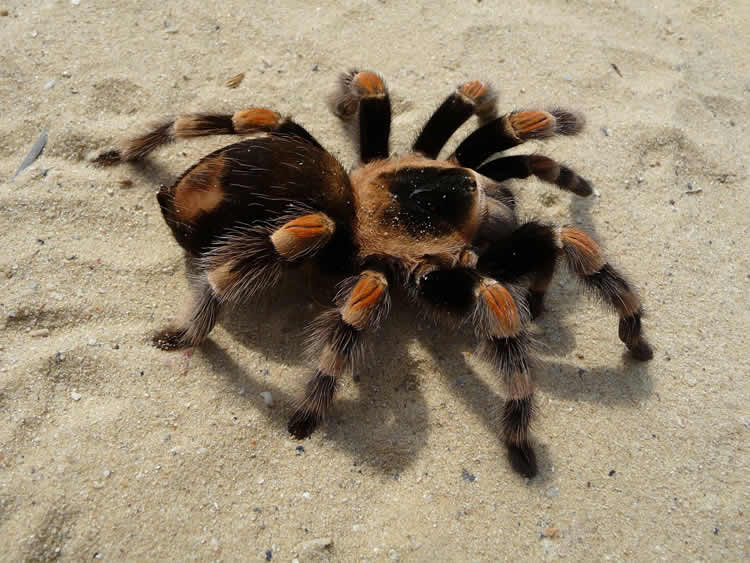Crucial experiments to develop a novel probe of cellular electrical activity were conducted in the Neurobiology course at the Marine Biological Laboratory (MBL) in 2013. Today, that optical probe, which combines a tarantula toxin with a fluorescent compound, is introduced in a paper in the Proceedings of the National Academy of Sciences.
The lead authors of the paper are Drew C. Tilley of University of California-Davis and the late Kenneth Eum, who was a teaching assistant in the Neurobiology course and a Ph.D. candidate at UC-Davis.
The probe takes advantage of the potent ability of tarantula toxin to bind to electrically active cells, such as neurons, while the cells are in a resting state. The team discovered that a trace amount of toxin combined with a fluorescent compound would bind to a specific subset of voltage-activated proteins (Kv2-type potassium ion channels) in live cells. The probe lights up cell surfaces with this ion channel, and the fluorescent signal dims when the channel is activated by electrical signals.

This is the first time that researchers have been able to visually observe these ion channels “turning on” without first genetically modifying them. All that is required is a means to detect probe location, suggesting that related probes could potentially one day be used to map neural activity in the human brain.
“This is a demonstration, a prototype probe. But the promise is that we could use it to measure the activity state of the electrical system in an organism that has not been genetically compromised,” says senior author Jon Sack, an assistant professor in the departments of Physiology and Membrane Biology at UC-Davis. Sack is a faculty member in the MBL Neurobiology course.
Since the probe binds selectively to one of the many different kinds of ion channels, it can help scientists disentangle the function of those specific channels in neuronal signaling. This can, in turn, lead to the identification of drug targets for neurological diseases and disorders.
“We have an incredible diversity of ion channels, and even of voltage-activated ion channels. The real trouble has been determining which ones perform which roles. Which ones turn on and when in normal nervous system functioning? Which are involved in abnormal states or syndromes?” Sack says. “The dream is to be able to see what the different types of ion channels are doing and when, to understand what they contribute to physiology and pathophysiology.”
The movie is quantitative imaging of cells with potassium channels, bathed in dilute fluorescent tarantula toxin. Pixel color indicates intensity of tarantula toxin concentration. The circular shapes are cell surfaces, illuminated by tarantula toxins bound to potassium channels. The cell on the right is electrically stimulated to the indicated voltages. The cells on the left remain at constant resting voltage. Intensity change reports activation of potassium channels. At -100 mV channels are at rest. During stimulus to 0 mV channels activate and fluorescence decreases as tarantula toxins fall off of potassium channels. Upon return to -100 mV, tarantula toxins find the resting channels again.
These probes respond to movement of ion channel voltage sensors, and it is particularly fulfilling to have conducted some of this work at the MBL, Sack says. The first measurements of voltage sensor movement were conducted at the MBL in the early 1970s by Clay M. Armstrong and Francisco Bezanilla. Armstrong and Bezanilla used electrophysiological methods to measure the movement of voltage sensors. The spider toxin probe create an optical signal when voltage sensors move, and no electrophysiology or genetic mutation of the channels is required.
This work was supported by the National Institute of Mental Health of the National Institutes of Health, the National Science Foundation (NSF) through the NSF CAREER Award and the Department of Defense through the National Defense Science and Engineering Graduate Fellowship Program.
Contact: Diana Kenney – Marine Biological Laboratory
Source: Marine Biological Laboratory press release
Image Source: The image is credited to WikiImages and is in the public domain
Video Source: The video “Chemoselective tarantula toxins report voltage activation of wild-type ion channels in live cells” is available at the mblwoodshole YouTube page
Original Research: Abstract for “Chemoselective tarantula toxins report voltage activation of wild-type ion channels in live cells” by Drew C. Tilley, Kenneth S. Eum, Sebastian Fletcher-Taylor, Daniel C. Austin, Christophe Dupré, Lilian A. Patrón, Rita L. Garcia, Kit Lam, Vladimir Yarov-Yarovoy, Bruce E. Cohen, and Jon T. Sack in PNAS. Published online October 20 2014 doi:10.1073/pnas.1406876111






